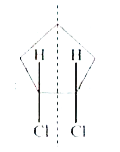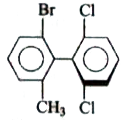Which of the following compounds is chiral?




The correct Answer is:B
To determine which of the given compounds is chiral, we will analyze each option for the presence of a plane of symmetry. A compound is considered chiral if it does not possess a plane of symmetry, meaning it cannot be superimposed on its mirror image.
1. Identify the Compounds: We have four cyclic compounds labeled A, B, C, and D. We need to analyze each compound for chirality.
2. Analyze Compound A:
- Visualize compound A as a hexagonal ring with substituents (ketone, Cl, and H).
- A plane of symmetry can be drawn through the compound, dividing it into two equal halves.
- Since it has a plane of symmetry, compound A is achiral.
3. Analyze Compound B:
- Visualize compound B as a six-membered ring with a ketone, Cl, H, and a double bond.
- Attempt to draw a plane of symmetry. The presence of the double bond means that the two sides of the compound are not identical.
- There is no plane of symmetry that can bisect this compound into two equal halves.
- Therefore, compound B is chiral.
4. Analyze Compound C:
- Visualize compound C as a five-membered ring with H, Br, and a double bond.
- A plane of symmetry can be drawn through the compound, bisecting it into two equal halves.
- Since it has a plane of symmetry, compound C is achiral.
5. Analyze Compound D:
- Visualize compound D as a three-membered ring with Cl and Br.
- A plane of symmetry can also be drawn through this compound, dividing it into two equal halves.
- Since it has a plane of symmetry, compound D is achiral.
6. Conclusion: After analyzing all four compounds, we find that only compound B does not possess a plane of symmetry and is therefore chiral.
Final Answer:
The chiral compound is Option B.
- Visualize compound A as a hexagonal ring with substituents (ketone, Cl, and H).
- A plane of symmetry can be drawn through the compound, dividing it into two equal halves.
- Since it has a plane of symmetry, compound A is achiral.
- Visualize compound B as a six-membered ring with a ketone, Cl, H, and a double bond.
- Attempt to draw a plane of symmetry. The presence of the double bond means that the two sides of the compound are not identical.
- There is no plane of symmetry that can bisect this compound into two equal halves.
- Therefore, compound B is chiral.
- Visualize compound C as a five-membered ring with H, Br, and a double bond.
- A plane of symmetry can be drawn through the compound, bisecting it into two equal halves.
- Since it has a plane of symmetry, compound C is achiral.
- Visualize compound D as a three-membered ring with Cl and Br.
- A plane of symmetry can also be drawn through this compound, dividing it into two equal halves.
- Since it has a plane of symmetry, compound D is achiral.
The chiral compound is Option B.
Similar Questions
Knowledge Check
A line which bisects a compound in two equal parts and both parts humou parto que ainda sono go appear to be the mirror image of each other, such kind of symmetry is known as plane of symmetry.
Any molecule that has a internal mirror plane of symmetry cannot be iis TV chiral, even though it may contain asymmetric carboni atoms.

Which of the following compounds is not chiral?A B
B C
C D
D
Which of the following dienes is chiral?
ACH3−CH2=C=CH2BCH3−CH=CH−CH=CH2CCH3CH=C=CHCH3DCH2=CH−CH2−CH=CH2Molecules whose mirror image is non-superimposable over them are known as chiral. Which of the following molecules is chiral in nature ?
A2-BromobutaneB1-BromobutaneC2-BromopropaneD2-Bromopropan-2-ol
Which of the following compounds is not chiral ?
View SolutionWhich of the following compounds is not chiral?
View SolutionWhich of the following molecule is chiral.
View SolutionMolecules whose mirror image is non-superimposable over them are known as chiral. Which of the following molecules is chiral in nature?
View SolutionMolecules whose mirror image is non-superimposable over them are known as chiral. Which of the following molecules is chiral in nature?
View Solution